Dr. Mittul Vahanvati, RMIT; Dr. Adriana Keating, Centre for Urban Research; Helen Cheng of The Fifth Estate writes:
Most of the time we discuss climate change as affecting cities and the people who live in them. Less well known is that cities – specifically their planning and design – also create climate change through the UHI (Urban Heat Island). Encouragingly, this means that cities can provide climate solutions.
There are a myriad of strategies being adopted by cities across the world to reduce Urban Heat Island (UHI) and adapt to climate change:
Green roofs and walls, increasing green space and canopy cover, urban farms, storing stormwater and increasing groundwater percolation, and expansion of highly reflective pavements are just some of the strategies being used, globally.
We must accept scientific evidence and work collaboratively
- Decisions must be evidence-based and be supported by political goodwill to allow for change to happen.
- Concerted action is required from state and local governments (especially amongst planners and urban designers), the private sector (especially architects and developers), researchers, the not-for-profit sector, and finally from city residents themselves.
Resilience thinking can help
- UHI and outdoor air quality (OAQ) are complex problems that require resilience thinking to understand how and where to make positive change.
- For example, addressing the UHI effect requires understanding the interrelations between urban morphology (grey infrastructure), green-blue infrastructure, local climatic conditions, and economic and political conditions and trends.
Nature based solutions
- A third key principle is the massive potential for nature-based solutions for reducing the UHI effect.
- These initiatives include green infrastructure such as street trees, parks and backyard gardens, and blue infrastructure such as water sensitive urban design and allowing rainwater to percolate in the soil. Not only does more green and blue space reduce heat, it has significant other for city residents and local biodiversity
Learn more:
Read more: How design of our cities is amplifying urban heat and what to do with it
 Greenroofs.comConnecting the Planet + Living Architecture
Greenroofs.comConnecting the Planet + Living Architecture






